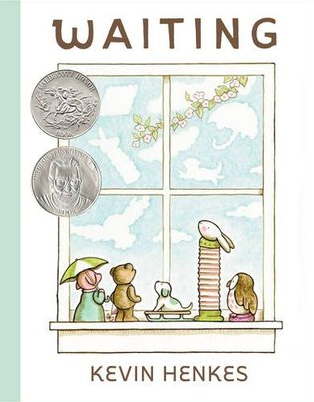Waiting
Book Module Navigation
Summary
Waiting inspires critical thought about the nature of happiness and its relationship with meaning.
Five toys sit on a windowsill looking for weather patterns that make them happy. While they are waiting, many things happen. They sleep. They meet and then lose a new friend. They see fireworks, rainbows, snowstorms, and thunderstorms. And they are always happy to see the wind, rain, moon, and snow. One day, a new friend arrives: a cat with patches, who did not seem to be waiting for anything — but she was! She gives birth to four baby kittens. In the end, the ten animals are happy together, “waiting to see what would happen next.”
Read aloud video with Kevin Henkes
Guidelines for Philosophical Discussion
Though seemingly without plot and therefore in need of much interpretation, Waiting by Kevin Henkes inspires critical thought about the nature of happiness and its relationship with meaning as the readers follow the lives of five toys on a windowsill. The narrator states that each toy is made happy by a different weather condition occurring on the other side of the window, but happiness itself is left undefined providing a perfect opportunity to discuss with kids the differences in approaches to the study of happiness in philosophy.
The first two sets of questions approach a definition of happiness and cover both of two major strains of thought on happiness. The first suggests that happiness can be understood as a psychological “state of mind” and the second as a “life that goes well for the person leading it.” One way to start this discussion is by having the students think about the question of what is “happiness” — how is it depicted in the story, and what do they themselves think it means to be happy. This leads into a discussion distinguishing between the two strains of happiness and testing their plausibility. Begin by discussing whether happiness is a mental state based in pleasure and satisfaction or a descriptor of well being. To start this discussion, one interesting thing to consider with the students is the question of whether feeling happy is the same thing as being happy or leading a good life. Here, it may be helpful to propose the idea of an imaginary new character. Let’s say we introduce a bully snake toy, who claims that it makes him happy to close the blinds so that none of the other toys can look out of the window to see the things that make them happy. Ask students to reflect on this and ask whether they think the snake leads a happy life. This gets at the important question of whether goodness is necessary for happiness.
Questions of happiness naturally lead into defining well-being and what is good for the individual, which can then transition into more abstract questions about well being and its relation to meaning. Philosophers suggest that happiness is not necessarily tied to meaningfulness. In some instances the two can come apart such as in a sacrifice where the needs and happiness of the individual are given up for the sake of the greater good. But if meaningfulness is not defined by what makes one happy on a day-to-day basis, how can we define meaning? One answer is that meaning has to do with purpose and coherence of a life. A great way of addressing this issue with kids is to use the word important and enter into a more abstract conversation about what things in life are important and worthwhile and why. Such a conversation should lead to possibly the most controversial question: even if the toys are happy, do their lives mean anything as they sit confined to a shelf?
Questions for Philosophical Discussion
The nature of happiness
- What makes the bear happy?
- Does the bear feel happy?
- Is happiness a feeling?
- Is the bear’s life a happy life?
- What makes you happy? How do you know when you are happy?
- Are the animals only happy when they see the things they want to see? Is it possible to be happy all the time? Is it possible to feel happy all the time?
Feeling happy, being happy, being good
“Let’s say we introduce a bully snake toy, who claims that it makes him happy to close the blinds so that none of the other toys can look out of the window to see the things that make them happy.”
- Does the snake feel happy?
- Is the snake happy?
- Is it possible to feel happy while making others unhappy?
- Is it possible to be happy by making other people unhappy?
- Is it possible to think you are happy when you are actually not happy?
- Can someone who is bad lead a happy life?
Meaning
- Do you think that the animals are only happy when they see the sun, moon, wind, and rain (the things that they are waiting for)?
- Is happiness the most important thing in life?
- If other things are more important than happiness, why are they more important?
- On the last page of the book, they are no longer waiting for the moon, rain, wind, and snow. Rather, they are simply “waiting to see what would happen next.” By the end of the book, do you think they have changed? What are they waiting for? What will happen next?
- Would you want to spend all of your time sitting on a windowsill and looking out the window? Why or why not? Could it make you happy? Would you feel like you were doing something meaningful?
Original questions and guidelines for philosophical discussion by Christian Purnell and Leah Meltzer. Edited May 2020 by The Janet Prindle Institute for Ethics.
Find tips for leading a philosophical discussion on our Resources page.






